|
|
| |
SPAIN
TOLEDO
Toledo sits above the the Tagus River 70km south of Madrid. The history of Toledo dates back to Roman occupation (Toletum) circa 192BC. The ruins of the Roman circus are still visible just outside the walls of the city. Toledo was the capital of the Spanish empire until the mid 1500's when the royal court moved to Madrid. It was declared a World Heritage Site by UNESCO in 1986 for its extensive cultural and monumental heritage as one of the former capitals of the Spanish Empire and place of coexistence of Christian, Jewish and Muslim cultures. The gold and black enamel work by local artisans is known throughout Spain. It is important to remember that the historic center of Toledo is rather steep and hilly and most streets are cobblestone, so sensible shoes are a must.
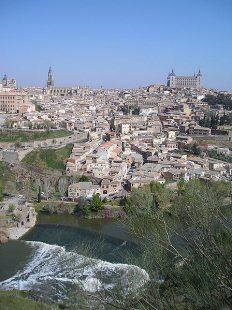 The old city of Toledo in Spain
as viewed from across the Tagus River
The Alcázar of Toledo, on the right
Cathedral of Toledo
The Primate Cathedral of Saint Mary of Toledoalso, also called Cathedral of Saint Mary of Toledo, is a Roman Catholic cathedral in Toledo. The cathedral of Toledo is one of the three 13th century High Gothic cathedrals in Spain and is considered to be the pinnacle of the Gothic style in Spain. The cathedrals construction began in 1226 during the reign of Ferdinand III and was finished in 1493. It was modeled after Bourges Cathedral however it also combines some characteristics of the Mudéjar style, mainly in the cloister, and with the presence of multifoiled arches in the triforium. It was built with white stone from Olihuelas, close to Toledo. The main façade faces onto an irregular square containing the town hall and Archbishop's Palace. To the left is the bell tower and to the right the projecting Mozarabic chapel that occupies the place where the second tower was to be built.
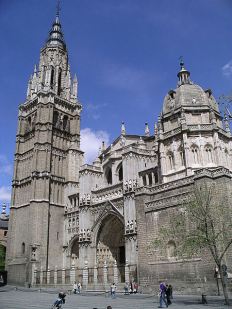 Primate Cathedral of Saint Mary of Toledo
Photo: Michael.chlistalla
The Alcazar is a large square fortification on the outskirts of the old city. It is located on the highest part of Toledo and looks across the river at Franco's old military barracks. It was once used as a Roman palace in the 3rd century, it was restored under Alfonso VI and Alfonso X and renovated in 1535. Today the Alcázar houses the Castilla-La Mancha Regional Library ("Biblioteca Autonómica") and the Museum of the Army ("Museo del Ejército").
Monasterio de San Juan de los Reyes
The Monasterio de San Juan de los Reyes is a historic monastery in Toledo. It was founded by King Ferdinand II of Aragon and Queen Isabella I of Castile to commemorate their victory at the Battle of Toro (1476) over the army of Afonso V of Portugal. Originally the monastery was dedicated to Saint John the Evangelist for use by Franciscan friars. The monastery is an example of Gothic-Spanish-Flemish style and is modeled in the form of Latin Cross. Its church is notable for its decoration of coats of arms of the Catholic Monarchs held by eagles.
 Monastery of San Juan de los Reyes
Photo: DaderotPalacio de Galiana
The Palacio de Galiana is a palace in Toledo on the borders of the Tagus River. It was built on the site of an earlier summer villa and garden of Al-Mamun, the king of the Taifa of Toledo, in the thirteenth century by king Alphonso X. The palace was built in the Mudéjar style and retains many characteristics of Moorish architecture in the Al-Andalus era. From the 1950s onwards the Palacio de Galiana was restored and its present garden designed by the architects Manuel Gomez Moreno and Fernando Chueca Goitia under the auspices of its owner Carmen Maranon.
Santa María la Blanca
Santa María la Blanca is a museum and former synagogue in Toledo, Spain. It is situated between the Church of San Juan de los Reyes and the Synagogue of El Transito. Erected in 1180, it is disputably considered the oldest synagogue building in Europe still standing. It is now owned and preserved by the Catholic Church. Its stylistic and cultural classification is unique as it was constructed under the Christian Kingdom of Castile by Islamic architects for Jewish use. It is considered a symbol of the cooperation that existed among the three cultures that populated the Iberian Peninsula during the Middle Ages. The synagogue is a Mudéjar construction, created by Moorish architects on Christian soil for non-Islamic purposes. But it can also be considered one of the finest example of Almohad architecture because of its construction elements and style.
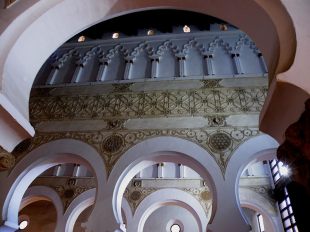 Sinagoga de Santa María la Blanca
Photo: kurtxio
The Castillo de San Servando is a medieval castle in Toledo next the Tagus River. It was begun as a monastery in 1088, three years after the city was conquered by the Christian army of Alfonso VI of Castile. Later it was converted into a fortress to protect the puente de Alcántara against a possible Muslim attack. With the disappearance of the Muslim threat, the fortress lost its importance and was neglected. In 1874 it was named a national monument.
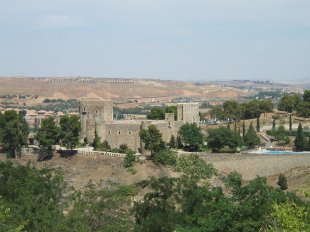 Castillo de San Servando
Photo: Bsm15Puerta de Bisagra Nueva
The Puerta de Bisagra Nueva ("The New Bisagra Gate") is the best known city gate of Toledo. The gate is of Moorish origin, but the main part was built in 1559 by Alonso de Covarrubias. It carries the coat of arms of the emperor Charles V. It superseded the Puerta Bisagra Antigua as the main entrance to the city.
Puerta de Bisagra
The Puerta de Bisagra is one of Toledo's city gates. It was built built in the 10th century, in the time of the taifa of Toledo. It is also called 'Bisagra Antigua' to distinguish it from the Puerta de Bisagra Nueva which was built in 1559. The gate was the main entrance to the city and dates from the Andalusian period.
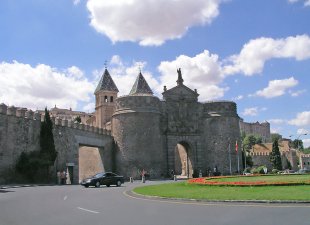 View of Puerta de Bisagra Nueva from the outside
Photo: Luis Fernández García
The San Martin Bridge is a medieval bridge situated across the river Tagus in Toledo. The bridge was constructed in the late 14th century by archbishop Pedro Tenorio to provide access to the old town from the west, complementing the older Puente de Alcántara linking to the east. Both sides of the bridge were heavily fortified with towers, the more recent dating from the 16th century. The Puente de San Martín features five arches, with the largest in the middle reaching an impressive span length of 40 m.
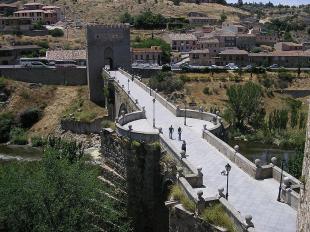 The Bridge of San Martín crossing the River Tagus
Photo: Armatura
|
|
|
Festivals & Events
Seville Fair
The Feria de abril de Sevilla, literally Seville April Fair, is held
in the Andalusian capital of Seville, Spain. The fair generally begins
two weeks after the Semana Santa, or Easter Holy Week. The fair
officially begins at midnight on Monday, and runs six days, ending on
the following Sunday. Each day the fiesta begins with the parade of
carriages and riders, at midday, carrying Seville's leading citizens
which make their way to the bullring, La Real Maestranza, where the
bullfighters and breeders meet.
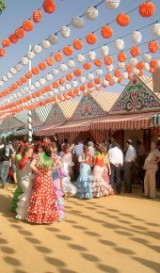 Casetas at Seville Fair
Photo: EdTarwinski
San Fermín
The festival of San Fermín is renowned for it's celebratory
tradition and is held in Pamplona anually on the 6th July. It is known
locally as Sanfermines and is held in honour of Saint Fermin. This
festival is important in terms of Spanish folklore and tradition. The
week long fiesta is most famous for it's encierro (running of the
bulls). It is belived that a million people flock to see this event
every year. The opening of the fiesta is marked by setting off the
pyrotechnic chupinazo. The rocket is launched at 12:00 noon on the 6th
of July from a city hall balcony with thousands of people celebrating
the act in the city hall square and other locations in Pamplona.
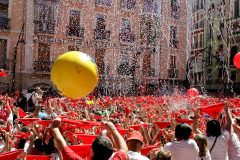 San Fermín Festival seen from
the Town Hall in Pamplona
Photo: Viajar24h
Fiestas del Pilar
Fiestas del Pilar is a large festival that takes place in Zaragoza,
Spain. This festival is religiously rooted in Spain and based on the
belief that Virgin Mary appeared to Saint James standing on a pillar.
The celebration lasts for seven days during which the city is bustling
with energy as over two million people visit the city for this fiesta.
Every day at 8 o'clock in the morning there is an event called
vaquillas, that is amateur bullfighting in the towns bullfighting ring,
or Plaza de toros. Everyone who is brave enough, can participate in this
event, in which many people get injured every year. The most important
celebration takes place on the 12th October, "The offering of flowers"
to the Virgin, who is removed from the Basilica and exhibited in a
platform placed on the square where the temple lies. The Offering of
Flowers is one of the more famous festive symbols of Spain.
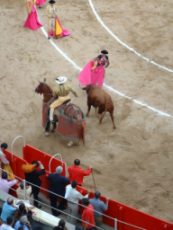 San Fermín Festival seen from
Bull running in Barcelona
Photo: BPG
Carnival
Carnival is a festive season which occurs immediately before Lent;
the main events are usually during February. Carnival typically involves
a public celebration or parade combining some elements of a circus,
mask and public street party. The Santa Cruz de Tenerifeand Las Palmas
de Gran Canaria is together with the Carnival of Cadiz, the most
important festival for Spanish tourism and Spain's largest carnival. In
Catalonia people dress up and organise parties for a week but
particularly on the weekend. Despite it being winter, parties are open
air, beginning with a cercavila to call everybody to come. Rues of
people dance along the streets. On Thursday Dijous Gras is celebrated,
also called 'the omelette day' and omelettes are eaten. Parties end by
burning Mr. Carnestoltes and with enterrament de la sardina (sardine's
funeral). Carnaval de Solsona takes place in Solsona, Lleida in central
Catalonia. It is one of the longest carnivals in Catalonia; free events
in the streets, and concerts every night, run for more than a week.
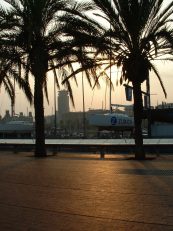 Barcelona harbour
Photo: BPG
Festival Internacional de Benicàssim
The Festival Internacional de Benicàssim is an annual music festival
sponsored by a well known beer label which takes place in the village of
Benicàssim, province of Castelló, Valencian Community in Spain. It
focuses mainly on pop, rock and electronica artists, as well as having
other elements besides music like short films, theatre, fashion and art.
Since the first festival in 1995, some of the most notable artists who
have played the festival include Paul Weller, Depeche Mode, Beck,
Radiohead, Kraftwerk, The Stone Roses, Brian Wilson, Blur, Lou Reed,
Oasis, The Chemical Brothers, Franz Ferdinand, The Killers, Morrissey,
Sigur Rós, Ride and The Strokes. As of 28 January, the line up for the
2011 Festival is as follows: Arcade Fire, Arctic Monkeys, Mumford &
Sons, Portishead, The Strokes, Beirut, Catpeople, Elbow, Friendly Fires,
Julieta Venegas, Lori Meyers, Primal Scream (present Screamadelica),
The Streets, Tinie Tempah, The Coronas, Grupo Salvaje, The Marzipan Man
Smile, Veronica Falls, Paolo Nutini, Pendulum, Mahmiri Acar. 'FIB' is
held in the seaside resort of Benicassim (Castellón province) on Costa
del Azahar, Valencia, Spain, 92.2 km away from Valencia Airport.
Festival goers who have purchased multi-day passes can camp for up to 9
days starting Monday before the festival starts and ending Tuesday after
the festival has ended. For more information please contact info@fiberfib.com
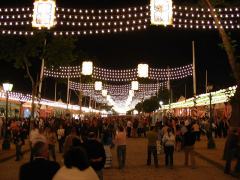
Festimad
Festimad is an alternative rock festival and cultural event held yearly
in Madrid, Spain since 1994, usually in the last week of May. Festimad
includes several parallel cultural festivals such as Performa, Graffiti,
Universimad o Cinemad, although its central event continues to be the
music festival, standing alongside the Festival Internacional de
Benicàssim as Spain's main rock concert. For more information please
contact festimad@festimad.es
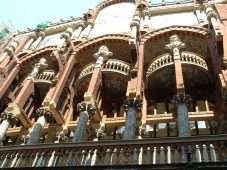 Photo: BPG
Bilbao Live Festival
The Bilbao Live Festival is a rock and pop music festival that takes
place in the summer in Bilbao, Spain since 2006. It is supported by BBK
the savings bank. Some 51,000 people attended the first edition of
Bilbao Live Festival in 2006, an event that reunited during three days
more than 40 national and international bands of rock and carps of
electronic music. Bilbao had thus burst in with force into the circuit
of great musical festivals of the summer time. The 2011 lineup includes
Coldplay, Blondie, Beady Eye, Crystal Castles, Russian Red, Ken Zazpi,
Amy Winehouse, Kasabian, Kaiser Chiefs, The Black Crowes, The Chemical
Brothers, Jack Johnson, 30 Seconds to Mars, M-Clan. For more information
please contact festivals@nme.com
|